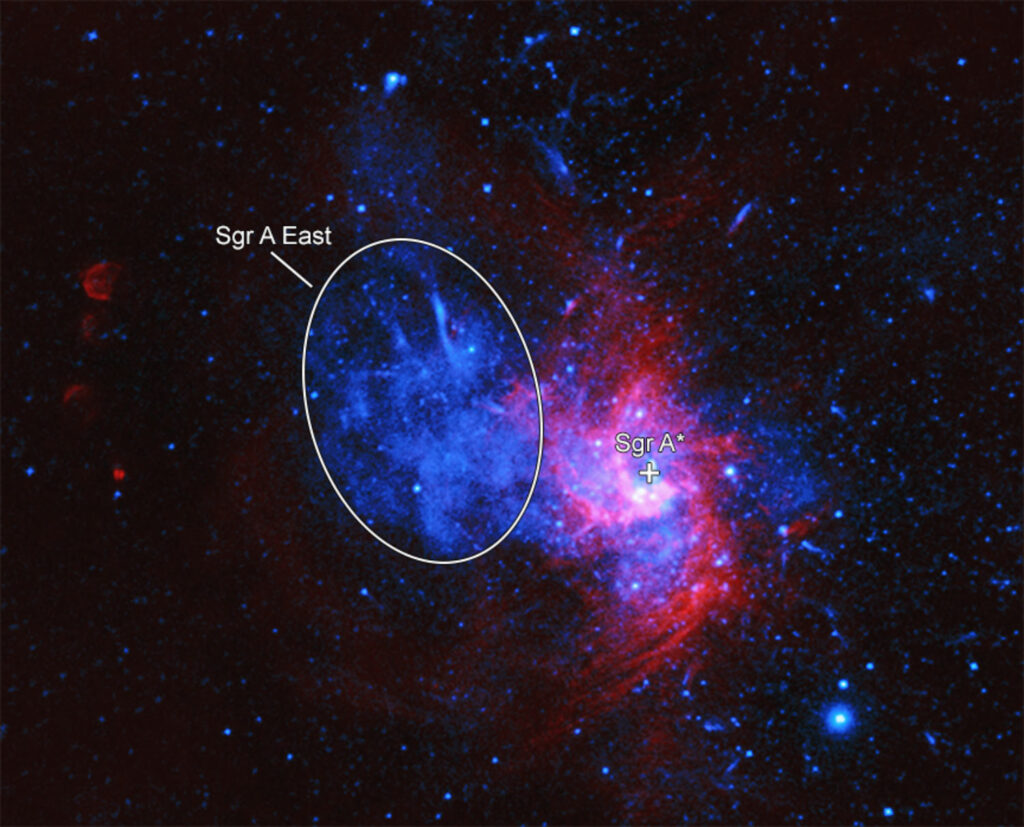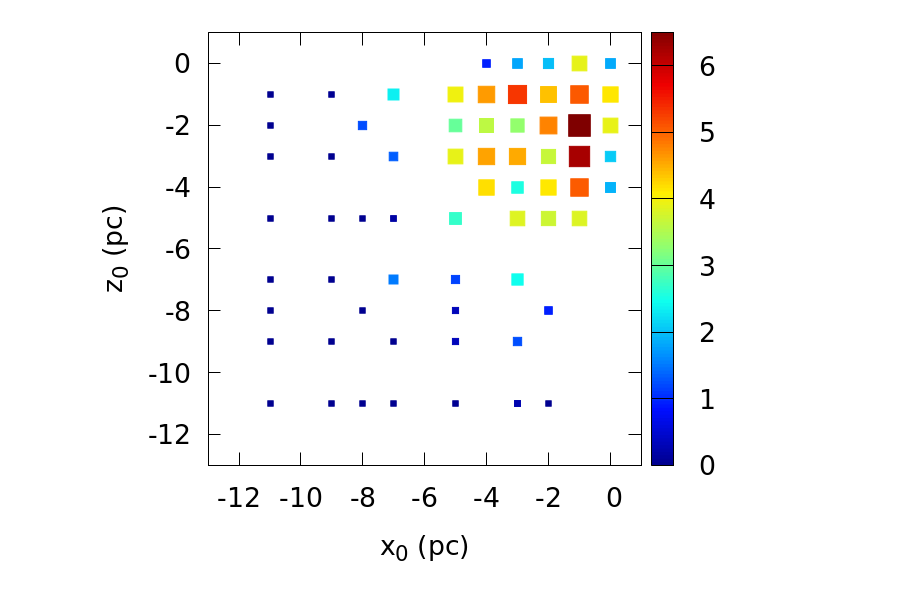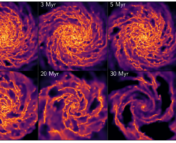Title: How to create Sgr A East: Where did the supernova explode?
Authors: S. Ehlerová, J. Palouš, M. R. Morris, R. Wünsch, B. Barna, and P. Vermot
First Author’s Institution: Astronomical Institute of the Czech Academy of Sciences, Prague
Status: Accepted by A&A

A supernova remnant is a track or a clue, which, if it is read correctly, can lead you to the details of a long past violent event: a supernova explosion.
What these spectacular final moments of large stars leave behind is most fascinating, beautiful and potentially holds a lot of information.
Supernova Remnant at the Galaxy’s Core
The authors of today’s paper set out to track down the origin of a supernova remnant known as Sagittarius A East (Sgr A East). If that name rings a bell, it is probably because you have heard of Sagittarius A* before, the supermassive black hole at the center of our Milky Way galaxy.
Sgr A East as well as Sagittarius A* are part of the complex radio source at the center of the Milky Way, known simply as Sagittarius A.
Clouds of dust and gas prevent optical telescopes from seeing into the galactic core, however, radio signals pierce through the veil and reveal much about the circumstances and occurrences within.
Sgr A East is the closest supernova remnant to the center of our galaxy but its age and exact origin are not entirely known.
Simulations to the rescue
In order to shed some light of the mysterious past of this object, the authors of today’s paper have conducted a simplified hydrodynamic simulation of the evolution of such a supernova remnant in the environment of the galactic core. The main components of this environment are the nearby massive molecular cloud, with which Sgr A East is known to interact, and the stellar wind blowing from the densely packed stars in the center of the Milky Way, known as the nuclear star cluster.
Besides the remnant of the supernova, there may be another trace of the original explosion present close by: a pulsar wind nebula called Cannonball. Some scientists believe this to be the actual stellar corpse of the event that created Sgr A East, which was left after the original massive star shed its outer layers and left the main sequence.
Whether Cannonball could actually be the neutron star connected to Sgr A East depends on the actual age of the remnant. Generally speaking, there are two educated guesses for this number: one prefers an age of around two thousand years, while the other estimates an age of around ten thousand years. These results come from previous investigations of Sgr A East.
Only the older age is compatible with Cannonball being connected to the explosion which created Sgr A East, since it would have otherwise already existed before that time.
There is more evidence supporting the age of around ten thousand years and Cannonball being what is left from the original star which collapsed and thus created Sgr A East: calculating back from its current velocity and direction of motion, it would have been located at the explosion site which created Sgr A East around 9 +/- 2 thousand years.
However, other models and investigations of this object have yielded results arguing for a much younger age of Sgr A East, even less than two thousand years.
So, more research is needed.
Fitting to reality
In order to recreate the shape, size and velocity of the expansion of Sgr A East, today’s authors employed a hydrodynamic code called RING. After running the code, the accuracy of the result is tested by a fitness function. This function expresses how well the properties and features of the simulated supernova remnant fit the data from observations of Sgr A East.
The interstellar medium was simulated with the aforementioned two components: the molecular cloud, Sgr A East interacts with, and the stellar wind of the nuclear star cluster. One of the free parameters determined by the simulation was the position of the original explosion. Since the authors did assume that Sgr A East ist on the younger side, the explosion site was constrained to be located not too far removed from where the remnant is today.
The simulations ran to an age of 30 thousand years, while the properties and parameter values for the modeled version of Sgr A East were extracted and recorded after each passing millennium for later use in the fitness function. Thus, the obtained values were compared to reality at a one thousand year interval in order to pin down an age for the remnant.

Source: Fig. 5 in today’s paper
Fig. 2 shows the results of the fitness function over the age range as well as cases for the interstellar medium being dominated only by the molecular cloud or only by the stellar wind of the nuclear star cluster. It is obvious that the simulations in general fit the observed properties of Sgr A East much better, if both the wind and the cloud are taken into account, and more specifically for ages of at least 5 thousand years. Below that limit, the agreement falls off sharply and the best fit was actually found for an age of ten thousand years, however ages of 19 and 29 thousand years cannot be excluded, as they display very high logarithms of the fitness function as well.

Where Everything Goes
The position of the original supernova explosion is actually constrained quite sharply by these models (see Fig. 3). It appears to lie within the expanding shell that is Sgr A East, around 3.7 pc from the supermassive black hole Sgr A*.

The best fitting model of Sgr A East (marked “A” in Fig. 2) as seen from the viewpoint of our Sun is shown in detail in Fig. 4. This also shows the location of the possible explosion site connected to this model as well as the location of the Neutron Star known as Cannonball. The direction of motion, as well as the velocity of this stellar remnant aligns very well with the predicted age of Sgr A East of this model (ten thousand years) as well as the predicted location of the original supernova explosion in this scenario. The star Cannonball was before its death could have possibly been located right where the model predicts the original explosion site and thus fits as the original source for this cosmic event.
The authors thus make a good case for the actual age of Sgr A East to be around ten thousand years and for Cannonball to be the stellar remnant of the same supernova explosion which created Sgr A East. However, there are still possibilities open for Sgr A East to be a few thousand years older and the authors acknowledge that several components of their simulation, such as the molecular cloud, could benefit from more refined modelling. In addition, more observations and more detailed determination of the properties of and surrounding Sgr A East may offer a better understanding of the object.
Sgr A East remains a fascinating clue for studying and understanding massive stellar deaths in the close vicinity of the galactic core.
Astrobite edited by Pratik Gandhi
Image Credits: NASA, NSF, today’s paper




